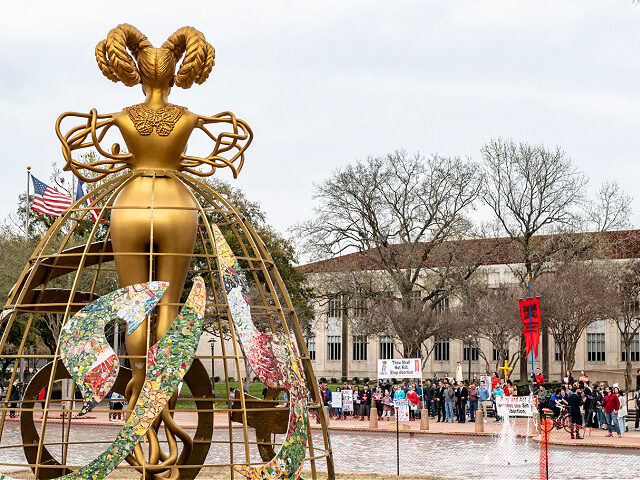An 18-foot horned statue featured at the University of Houston — and dubbed by pro-life groups as “Satanic” — was beheaded during Hurricane Beryl on Monday, the New York Times reported.
The sculpture is called “Witness” and is part of a three-part installation from artist Shahzia Sikander called Havah… to breathe, air, life. The sculpture is a naked female figure with braids gnarled into goat horns, arms like tentacles, and a judicial lace collar to pay homage to the late Supreme Court Justice Ruth Bader Ginsburg, a strong supporter of abortion.
University officials announced on Tuesday that a vandal had attacked the sculpture, according to the report. Officials reportedly told Sikander that campus police have footage of the incident, which occurred amid intense weather and power outages during Hurricane Beryl.
“We were disappointed to learn the statue was damaged early Monday morning as Hurricane Beryl was hitting Houston. The damage is believed to be intentional,” Kevin Quinn, executive director of media relations for the university, said in a statement to the Times. “The University of Houston Police Department is currently investigating the matter.”
The statue has been under “increased surveillance” after pro-life groups spoke out against it following its installation in February, according to the report. The university ended up canceling a talk by Sikander, as well as the opening celebration for the piece. Pro-life demonstrators also held a small protest near the installation. University officials and police have not released a motive behind the vandalism.
“It was a very violent act of hate, and it should be investigated as a crime,” Sikander said in a phone interview with the Times on Tuesday.
The artist also claimed to the Times that the intention of the installation was not to specifically comment on abortion or Supreme Court justices, “but rather to create a broader message about a woman’s power in the justice system,” the report reads.
However, in a lengthy artist statement, Sikander specifically mentioned her work — which includes a similar sculpture atop the New York City courthouse called “NOW” — being influenced by “the recent focus on reproductive rights” following the end of Roe v. Wade, a 1973 Supreme Court decision which had invented a constitutional right to abortion for 50 years. She wrote:
The recent focus on reproductive rights in the United States after the Supreme Court overturned the landmark 1973 decision of Roe v. Wade, which guaranteed the constitutional right to abortion, comes to the forefront. In the process, is the dismissal, too, of the indefatigable spirit of women who have been collectively fighting for their right to their own bodies over generations. However, the enduring power lies with the people who step into and remain in the fight for equality. That spirit and grit is what I want to capture in both the sculptures.
In recent surveys, much of the public regards the court as partisan and political in the way it exerts power. The luminous figure is a nod to Ruth Bader Ginsburg, as seen in the detail adorning her collar. With Ginsburg’s death and the reversal of Roe, there was a setback to women’s constitutional progress.
In the title of the three-part installation, havah is taken from the word meaning “air” or “atmosphere” in Urdu and “Eve” in Arabic and Hebrew, according to the Public Art University of Houston System, which notes that the installation is supposed to go through October of 2024.
In The Art Newspaper, Sikander reportedly said she wants the figures to work as icons of resistance and quipped, “Eve is also the first law-breaker, right?”
In February, Texas Right to Life put out a statement slamming the installation, which it called an “idol.”
“Disobedience to God certainly should not be esteemed by society, much less lauded with a statue. On the contrary, art should reflect truth, goodness, and beauty: three timeless values that reveal the nature of God. Art cannot have beauty without truth. Art cannot have truth without goodness,” the group said. “A statue honoring child sacrifice has no place in Texas.”
Texas Values, which has previously criticized the statue, disavowed the vandalism and ultimately called for the removal of the sculpture.
“Our thoughts and [prayers] go out to the victims of any possible senseless attack. We would never condone such violence/destruction/property, but since it has been defaced, it’s probably best for UH to remove it,” Texas Values president Jonathan Saenz said in a post to X.
Sikander told the Times she wants to leave the damaged sculpture standing.
“I don’t want to ‘repair’ or conceal,” she said. “I want to ‘expose,’ leave it damaged. Make a new piece, and many more.”
Katherine Hamilton is a political reporter for Breitbart News. You can follow her on X @thekat_hamilton.



COMMENTS
Please let us know if you're having issues with commenting.